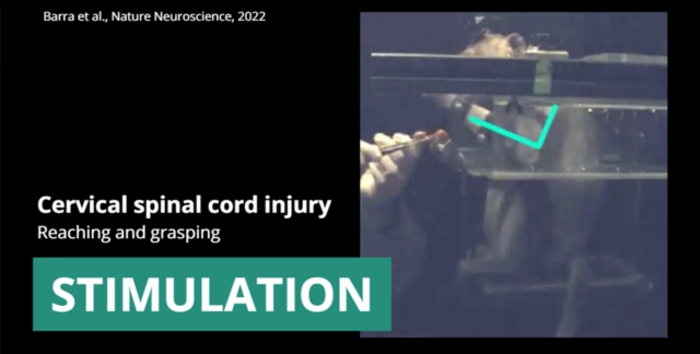PITTSBURGH, June 30, 2022 – Electrical stimulation of surviving nerves of the upper spinal cord damaged by severe injury can improve motor control of the upper limb and allow individuals with limited arm function to partially regain lost movement, report University of Pittsburgh researchers. The first round of pre-clinical experimental data was published in Nature Neuroscience today.

Credit: Marco Capogrosso, University of Pittsburgh
PITTSBURGH, June 30, 2022 – Electrical stimulation of surviving nerves of the upper spinal cord damaged by severe injury can improve motor control of the upper limb and allow individuals with limited arm function to partially regain lost movement, report University of Pittsburgh researchers. The first round of pre-clinical experimental data was published in Nature Neuroscience today.
“To perform even the simplest arm movement, our nervous system has to coordinate hundreds of muscles, and replacing this intricate neural control with direct electrical muscle activation would be very difficult outside a laboratory,” said senior author Marco Capogrosso, Ph.D., assistant professor of neurological surgery and member of the Rehabilitation and Neural Engineering Labs at Pitt. “Instead of stimulating muscles, we simplified the technology by designing a system that uses surviving neurons to restore the connection between the brain and the arm via specific stimulation pulses to the spinal cord, potentially enabling a person with paralysis to perform tasks of daily living.”
Deficits in arm and hand mobility—ranging from limitations in bending the wrist to inability to move one’s arm at all—are some of the most life-altering complications that stroke patients and people who have been paralyzed are forced to contend with. Even mild deficits to arm and hand function significantly limit patients’ quality of life and their autonomy, making restoration of upper limb control an important focus in the field of neurorehabilitation.
Yet, there are no therapies or medical technologies that allow patients to restore or meaningfully improve their lost upper limb function.
A wide range of upper limb motions and superior dexterity sets primates and humans apart from other mammals. The ability to rotate the arm in the shoulder, bend it at the elbow, flex and extend the wrist and alter the grip by changing positions of individual fingers allows for extraordinarily complex control of the way we hold objects and otherwise interact with the world. That amazing ability is also what makes restoration of arm and hand movement extraordinarily difficult.
Pitt researchers were faced with a challenging task: Develop a technology that could activate the remaining healthy nerves connecting the brain and the spinal cord to control muscles of the arm using external stimuli. The technology also had to be seamless and require little to no training to use, allowing the individuals to continue familiar motor tasks the way they did before their injury.
To test the technology, researchers worked with macaque monkeys with partial arm paralysis who were trained to reach, grasp and pull a lever to receive their favorite food treat.
In addition to brain implants detecting electrical activity from regions controlling voluntary movement, the monkeys were implanted with a small array of electrodes connected to an external stimulator the size of a pencil-top eraser, which were transiently turned on when brain electrodes detected the animal’s intention to move its arm.
“Our protocol consists of simple stimulation patterns that are initiated by detection of the animal’s intention to move,” said co-first author Sara Conti, Ph.D., at Harvard Medical School and Boston Children’s Hospital. “We don’t need to know where the animal wants to move; we only need to know that they want to move, and extracting that information is relatively simple. Our technology could be implemented in clinics in many different ways, potentially without requiring brain implants.”
The electrodes and the stimulator’s design and placement—over the nerve roots sprouting from the spinal cord toward the muscles of the arm and hand—were extensively verified using a combination of computational algorithms and medical imaging, ensuring that each animal’s unique anatomy was compatible with the device.
The analysis showed that, while not enough to restore the arm function completely, stimulation significantly improved precision, force and range of movement, allowing each animal to move its arm more efficiently. Importantly, the animals continued to improve as they adapted and learned how to use stimulation.
“Taking a step back and tackling a very complex clinical problem from a different and simpler perspective compared to anything that was done before opens more clinical possibilities for people with arm and hand paralysis,” said co-first author Beatrice Barra, Ph.D., former doctoral student at the University of Fribourg in Switzerland and visiting scholar at Pitt, currently at New York University. “By building a technology around the nervous system that mimics what it is naturally designed to do, we get better results.”
A clinical trial testing whether electrical spinal cord stimulation could improve arm and hand control in patients who have had strokes is recruiting participants at the University of Pittsburgh and UPMC.
Additional authors of this paper are Matthew Perich, Ph.D., and Tomislav Milekovic, Ph.D., both at University of Geneva; Katie Zhuang, Ph.D., Mélanie Kaeser, Ph.D., Maude Delacombaz, Ph.D., Eric Rouiller, Ph.D., all at University of Fribourg, Switzerland; Giuseppe Schiavone, Ph.D., Florian Fallegger, Ph.D., Katia Galan, Ph.D., Nicholas James, Ph.D., Quentin Barraud, Ph.D., Stephanie Lacour, Ph.D., Jocelyne Bloch, Ph.D., and Grégoire Courtine, Ph.D., all at École Polytechnique Fédérale de Lausanne, Geneva.
This research was supported by a Wyss Center grant (WCP008), ONWARD Medical, the Bertarelli Foundation, Swiss National Science Foundation Ambizione Fellowship (No. 167912) and Doc-Mobility grant (188027), The European Union’s Horizon 2020 research and innovation program under the Marie Skłodowska-Curie grant agreement (665667), a Swiss National Foundation grant (BSCGI0_157800), Whitaker International Scholars Program fellowship and internal funding from the University of Fribourg and Pitt.
Journal
Nature Neuroscience
DOI
10.1038/s41593-022-01106-5
Method of Research
Experimental study
Subject of Research
Animals
Article Title
Epidural electrical stimulation of the cervical dorsal roots restores voluntary upper limb control in paralyzed monkeys
Article Publication Date
30-Jun-2022




